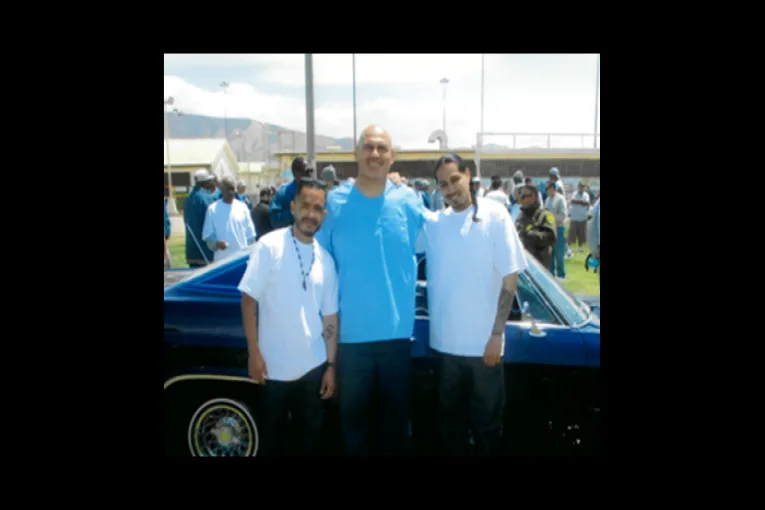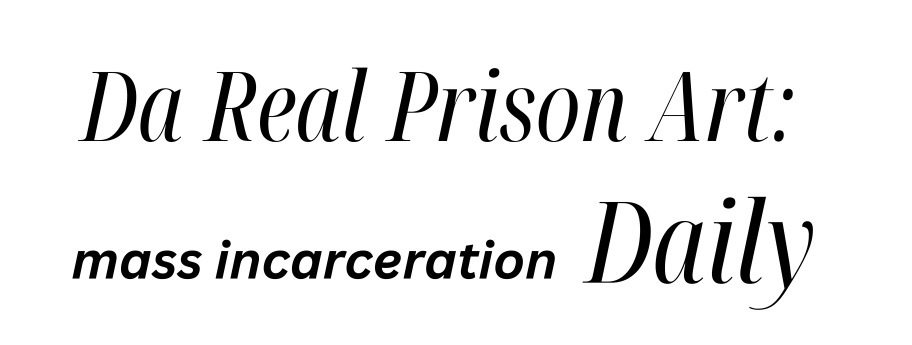
UFC Champ Uses Holotropic Breathing Exercises to Teach Emotional Regulation Behind Bars
By Ghostwrite Mike, The Mundo Press, & Cain Velasquez
Defending a submission attempt during a globally-distributed pay-per-view brawl has a lot in common with a night vision-assisted special operations war fighter kicking in a distant enemy door. Each requires the same unique ability: remaining calm during chaotic, volatile, and potentially deadly situations. Thankfully, humans have gotten good at conditioning the body to overcome some of its innate design features. Cain Velasquez has found a novel but practical way to translate a nonviolent fighting skill into a useful form of self-help medicine for people living in confinement.
Physiologically, overriding our fight/flight/freeze hardwiring is contrary to what the human body is designed to do; and yet, for many people in prison—particularly those who have committed a violent crime—this is precisely the sort of self-regulation tool that can save lives. At the center of this praxis is holotropic breathing, a modality developed by Stanislav Grof that uses diaphragm hyperventilation to normalize altered states of nervous system stimuli in order to exercise one’s ability to cope, focus, and perform in high-stress situations.
“This is a critical life skill we all need to learn, in prison or not, because what precipitates every act of violence is the dissonance between people that erupts from disagreement. What happens to us in those moments when we allow anger to move us into actual aggression is the teachable moment opportunity we have to master our thoughts and emotions,” said Jeremiah Velasquez, a certified Offender Mentor at CTF-North.
MUNDO: Tell me about the adjustment to prison life.
CAIN: This is my first time—my first experience. Coming here to Soledad, I didn’t know what to expect. You know, I’ve seen movies and people talk about their experiences, but generally, I’ve been just pleasantly surprised at how amazing, on both sides, the people here are—the officers, fellow inmates. On the outside, we don’t really get a chance to do that self-reflection, day in and day out. I’m not sure about across the U.S., but I feel like here in Soledad, people are doing the correct thing. We’re all coexisting, helping each other out, and everyone gets that time to really go within and to really work on themselves. I believe we’re doing the work the way it’s supposed to be done, so it’s a beautiful thing.
At CTF-North, Soledad hosts both the Compassion Prison Project’s Trauma Talks series and the Freedom Libraries furnished by Dwayne Betts’ Freedom Reads, a Mellon-funded initiative that positions works by scholars like Yale’s Elizabeth Hinton, whose book From the War on Poverty to the War on Crime: The Making of Mass Incarceration in America chronicles the bipartisan policy decisions that drove the racially motivated mass criminalization of urban spaces at least two decades before the so-called war on drugs in the 1980s.
“The learning environment here at CTF-North is unique,” says Jeremiah, “owing to the temperature set by our administration, which in turn sets a tone for how custody works with us. Other places are called the California Model, but the alchemy we experience here is rare. It feels like we are modeling, in a small way, what real prison reform might look like. When mature folks decide to collaborate, and the staff allow us the agency to convene, commune and work on ourselves, that is exactly what we do. We work, in earnest.”
OMCP mentors like Jeremiah, who was trained at Valley State Prison (VSP) and deployed to CTF, exemplify the self-help democratization sweeping U.S. prisons.
MUNDO: People always express what prison has taken from them, but what has it given you? Have you had a teachable moment during your time?
CAIN: Everyone knows why I’m here. The goal is to learn from my experiences, go home as quick as possible, not get caught up in division, whether you come from a certain place, what type of crime you committed. We’re all here for the same thing—to better ourselves. Everyone is looking at their past trauma. You’re always working on yourself. Have compassion for each other. We’re all going to the same place. I’ve been blessed to share knowledge with my fellow brothers. For youth offenders, you’re in charge. You are sourced from God. Whatever you’ve grown up hearing people tell you what you are, that’s not it. Be patient with yourself. Everyone is a creator. Share wisdom. Everyone is getting rid of baggage as we go on, getting wisdom, healing. Learn, and forgive.
It is profoundly disarming to see one of the planet’s most dangerous and powerful humans—a man who possesses the audacious capacity to incapacitate a foe with tactical efficiency—move through the prison landscape in peace. To be in proximity to that awesome power, know its potential, and yet see it throttled in selfless solidarity, conveys a spirituality rooted in a humility rarely found in prison. To hear Cain speak about coexistence in a place known for its fractured politics and structured violence cuts exceptionally against the grain.
Famous residents of the carceral state enjoy a unique experience while doing their time, but few engender the goodwill Cain is enveloped by at CTF. He’s found a way to extract from his arsenal a gift he has given the population that affirms self-control and peace in a physical manner that serves the common good.
MUNDO: We introduced a breathing element in our Barz Behind Bars workshop, but you’ve created a full-blown mentorship class using a breathing method to bring clarity to one’s consciousness. What inspired it?
CAIN: I’ve really gotten into plant medicine. It’s helped me find my heart more and see God everywhere. I started being open with people—I got this breath work—we need a lot of healing, and I know there’s a spiritual practice beyond that, but whether it’s cold plunges, or meditation, holotropic breath work produces DMTs. What you’re gonna get is a repairing and recovering—pretty much running the body. I believe this breath work is one of the best things we can do to emotionally stay regulated.
Jeremiah, who began his prison journey at the age of 16 as a youth offender, and has taken Cain’s class repeatedly, said, “I was immediately struck by the calming presence Cain had as he gave instruction. I went in with an open mind, and have been a part of many self-help groups that have helped me, but his breath work group was by far the best as far as experience. I was able to turn a lot of pain and hurt, my resentment and hidden anger into compassion and a deep sense of gratitude. I smiled, I cried and really tapped into something special. I’ve went four times and each experience has been unique, but never fails to teach me something new.”
One of the biggest knocks on any group modality is that it can’t be repurposed or reused by the same participants; however, experiential groups that involve physicality tap into a physiological domain that more closely approximates the emotional flooding that happens with real anger or relational volatility. The trick in prison, particularly, is to get participant buy-in, get people to voluntarily allow themselves to get uncomfortable, and inspire them to explore that discomfort in a place where everybody is stressed, projecting faux power, and afraid to be vulnerable. Not an easy feat to pull off. Perhaps being mentored by one of the world’s most dangerous men just happens to be the sneaky elixir the rest of us have always needed in order to drop our own masks, submit, trust the process, and explore our hidden selves.
MUNDO: I’ve taken your class, and yours is a different experience, my boy. When I started breathing, listening to your voice coaching and the music, I noticed within like five minutes of focus, my hands, face and feet had a tingling sensation—I felt awareness, peace, and a feeling of pleasure throughout my being. It was almost like an outer body experience. It was blissful. Would you be interested in bringing this class to other prisons or juvenile halls after your release to normalize emotional regulation?
CAIN: Yeah, definitely. Also meditation. As long as everybody is open to it, I’m open to it. You know, we’re all here to do the same thing here, to share.
The Harvard-Yale Institute on Policing, Incarceration, and Public Safety (IPIPS) recently announced its Inside Knowledge initiative, which supports multiple interdisciplinary peer-facilitated self-help modalities recently launched at Valley State Prison’s Honor Block on C-Yard. Among those programs are the Carceral Studies Journalism Guild workshop, the My Teachable Moment oral history project, and the Barz Behind Bars: Healing Through Verse literacy initiative, which hopes to pollinate at CTF-North.
Jeremiah, a veteran facilitator of NA, CGA, and Life C.Y.C.L.E. groups, hopes to see IPIPS programs come to CTF, saying, “I believe BARZ will be a great contribution to the community here at CTF, because it’s like the salt that’s added to a meal to truly bring out the ingredients present. Here we have the staff, a recovery-centered population, and the space to make BARZ a success. The level of talent, combined with the open-mindedness of the population to dig deep, can be a beautiful opportunity to witness the potential of the human spirit to practice modern day alchemy, convert pain into purpose, shift the mess into a message, and turn setbacks into comebacks. The Freedom Reads books are here—we can map a path toward empathy, literacy, and artistic agency—maybe cultivate a local media program.”
Hinton, a veteran in-prison college instructor for the Mellon-funded Yale Prison Education Initiative and co-executive director of Harvard-Yale IPIPS, hopes to see BARZ finally embraced as a credit-earning modality. “Our revised version of the IPIPS BARZ curriculum demands 45 unique writing assignment outcomes involving 3 forms—essays, poems, and free-write journaling—over the course of 15 weeks,” explains Hinton. “By comparison, the BARZ writing volume is greater than every English college course offered via every college degree program available at Valley State, and the writing prompt subject matter diversity is 45 topics deep. In fact, in terms of both word count and topic variety, no credit-earning self-help modality offered in any California prison is as rigorous as BARZ—it’s not even close. It would be great to see that hard work become finally deemed worthy of sentence reduction credits by a progressive administration, if only on a pilot basis.”
CAIN: You’re listening to Inside Knowledge with The Mundo Press and Ghostwrite Mike. This is Cain Velasquez, coming to you live from Soledad – North Yard, reminding every person who can hear me and is living in confinement right now to breathe, read, and stay centered. Barz Behind Bars, Freedom Reads, I got you.
Read the Journal of Prison Education Research (JOPER) practitioner paper deconstructing the BARZ workshop: https://scholarscompass.vcu.edu/joper/vol9/iss1/1
Look for the full Inside Knowledge audio version of the Cain Velasquez interview with The Mundo Press coming soon to Edovo.
Brittney Gates, a carceral rehabilitation mentor and reentry advocate, contributed generously to the production of this content. To be featured on the Witness platform, pitch your program or story concept to Ghost via email: ghostinsideknowledge@gmail.com.
Categories:
Breaking News Everyday Injustice Witness
Tags:
Cain Velasquez Dwayne Betts Elizabeth Hinton Freedom Libraries Jeremiah Velasquez JOPER Mellon-funded Yale Prison Education Initiative Stanislav Grof The Mundo Press
This post was originally published on this site be sure to check out more of their content.








